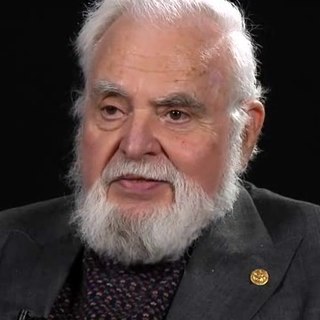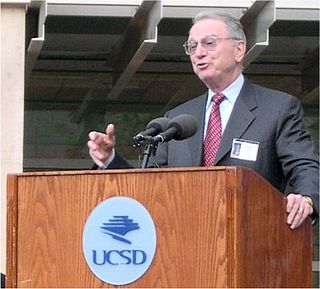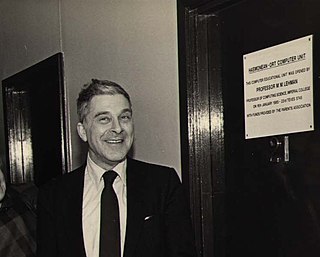Leo Joskowicz from The Hebrew University of Jerusalem, Jerusalem, Israel was named Fellow of the Institute of Electrical and Electronics Engineers (IEEE) in 2013 [1] for contributions to computer assisted surgery and medical image processing.
Leo Joskowicz from The Hebrew University of Jerusalem, Jerusalem, Israel was named Fellow of the Institute of Electrical and Electronics Engineers (IEEE) in 2013 [1] for contributions to computer assisted surgery and medical image processing.

Ralph C. Merkle is an American computer scientist and mathematician. He is one of the inventors of public-key cryptography, the inventor of cryptographic hashing, and more recently a researcher and speaker on cryonics.

Robert Elliot Kahn is an American electrical engineer who, along with Vint Cerf, first proposed the Transmission Control Protocol (TCP) and the Internet Protocol (IP), the fundamental communication protocols at the heart of the Internet.

Neil James Alexander Sloane FLSW is a British-American mathematician. His major contributions are in the fields of combinatorics, error-correcting codes, and sphere packing. Sloane is best known for being the creator and maintainer of the On-Line Encyclopedia of Integer Sequences (OEIS).

Robert Gray Gallager is an American electrical engineer known for his work on information theory and communications networks.

Solomon Wolf Golomb was an American mathematician, engineer, and professor of electrical engineering at the University of Southern California, best known for his works on mathematical games. Most notably, he invented Cheskers in 1948. He also fully described polyominoes and pentominoes in 1953. He specialized in problems of combinatorial analysis, number theory, coding theory, and communications. Pentomino boardgames, based on his work, would go on to inspire Tetris.
Thomas Kailath is an Indian born American electrical engineer, information theorist, control engineer, entrepreneur and the Hitachi America Professor of Engineering emeritus at Stanford University. Professor Kailath has authored several books, including the well-known book Linear Systems, which ranks as one of the most referenced books in the field of linear systems.

Irwin Mark Jacobs is an American electrical engineer and businessman. He is a co-founder and former chairman of Qualcomm, and chair of the board of trustees of the Salk Institute. As of 2019, Jacobs has an estimated net worth of $1.2 billion.

Éva Tardos is a Hungarian mathematician and the Jacob Gould Schurman Professor of Computer Science at Cornell University.

Jun-ichi Nishizawa was a Japanese engineer and inventor. He is known for his electronic inventions since the 1950s, including the PIN diode, static induction transistor, static induction thyristor, SIT/SITh. His inventions contributed to the development of internet technology and the information age.

Meir "Manny" Lehman, FREng was a professor in the School of Computing Science at Middlesex University. From 1972 to 2002 he was a Professor and Head of the Computing Department at Imperial College London. His research contributions include the early realisation of the software evolution phenomenon and the eponymous Lehman's laws of software evolution.
Marc Snir is an Israeli-American computer scientist. He holds a Michael Faiman and Saburo Muroga Professorship in the Department of Computer Science at the University of Illinois at Urbana-Champaign. He currently pursues research in parallel computing. He was the principal investigator (PI) for the software of the petascale Blue Waters system and co-director of the Intel and Microsoft-funded Universal Parallel Computing Research Center (UPCRC).
Heung-Yeung "Harry" Shum is a Chinese computer scientist. He was a doctoral student of Raj Reddy. He was the Executive Vice President of Artificial Intelligence & Research at Microsoft. He is known for his research on computer vision and computer graphics, and for the development of the search engine Bing.

Harold Vincent Poor FRS FREng is the Michael Henry Strater University Professor of Electrical Engineering at Princeton University, where he is also the Interim Dean of the School of Engineering and Applied Science. He is a specialist in wireless telecommunications, signal processing and information theory. He has received many honorary degrees and election to national academies. He was also President of IEEE Information Theory Society (1990). He is on the board of directors of the IEEE Foundation.
Arie E. Kaufman is an Israeli-American computer scientist best known for his work in volume visualization and virtual reality. Dr. Kaufman is Distinguished Professor and Chair of the Department of Computer Science at Stony Brook University, where he is also Director of the Center for Visual Computing (CVC), and Chief Scientist at the Center of Excellence in Wireless and Information Technology (CEWIT). He has an H-Index of 84 and is currently the ninth most cited researcher in the world working in the area of visualization.
Leonard J. Y. Schulman is professor of computer science in the Computing and Mathematical Sciences Department at the California Institute of Technology. He is known for work on algorithms, information theory, coding theory, and quantum computation.
Reimund Gerhard is a German applied physicist and university professor. Between 1979 and 2006 he used the last name "Gerhard-Multhaupt".
Miriah Meyer is an American computer scientist and USTAR professor at the University of Utah. She is noted for her pioneering work in data visualization for research applications. She received an American Association for the Advancement of Science Mass Media Science & Engineering Fellowship in 2006 and served as a reporter for The Chicago Tribune. She was named in MIT Technology Review's TR35 list in 2011 and Fast Company's list of the 100 most creative people in 2012. She was named a 2013 TED Fellow for her work in interactive visualization.

Henry Cohn is an American mathematician. He is a principal researcher at Microsoft Research and an adjunct professor at MIT. In collaboration with Abhinav Kumar, Stephen D. Miller, Danylo Radchenko, and Maryna Viazovska, he solved the sphere packing problem in 24 dimensions. In 2003, with Chris Umans he initiated a group-theoretic approach to matrix multiplication, and is a core contributor to its continued development with various coauthors.
As of 2023, the Institute of Electrical and Electronics Engineers (IEEE) has 7,236 members designated Fellow, each of whom is associated with one of the 41 societies under the IEEE.
Alla Sheffer is a Canadian researcher in computer graphics, geometric modeling, geometry processing, and mesh generation, particularly known for her research on mesh parameterization and angle-based flattening. She is currently a professor of computer science at the University of British Columbia.